Yongwei Zhao
DA-Ada: Learning Domain-Aware Adapter for Domain Adaptive Object Detection
Oct 11, 2024
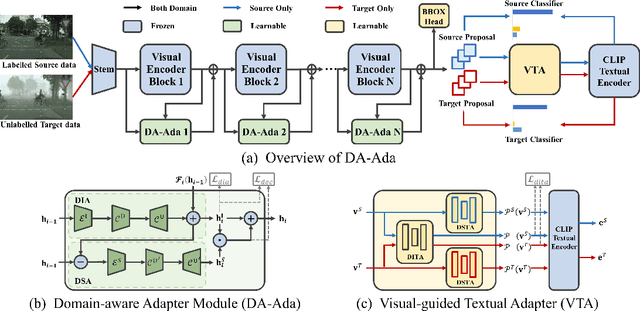
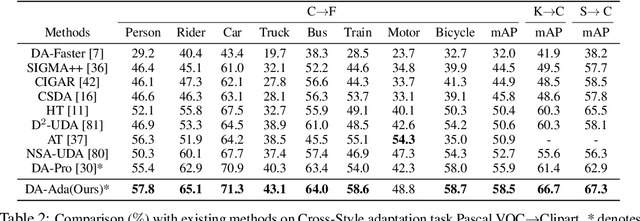

Abstract:Domain adaptive object detection (DAOD) aims to generalize detectors trained on an annotated source domain to an unlabelled target domain. As the visual-language models (VLMs) can provide essential general knowledge on unseen images, freezing the visual encoder and inserting a domain-agnostic adapter can learn domain-invariant knowledge for DAOD. However, the domain-agnostic adapter is inevitably biased to the source domain. It discards some beneficial knowledge discriminative on the unlabelled domain, i.e., domain-specific knowledge of the target domain. To solve the issue, we propose a novel Domain-Aware Adapter (DA-Ada) tailored for the DAOD task. The key point is exploiting domain-specific knowledge between the essential general knowledge and domain-invariant knowledge. DA-Ada consists of the Domain-Invariant Adapter (DIA) for learning domain-invariant knowledge and the Domain-Specific Adapter (DSA) for injecting the domain-specific knowledge from the information discarded by the visual encoder. Comprehensive experiments over multiple DAOD tasks show that DA-Ada can efficiently infer a domain-aware visual encoder for boosting domain adaptive object detection. Our code is available at https://github.com/Therock90421/DA-Ada.
Emergent Communication for Rules Reasoning
Nov 08, 2023



Abstract:Research on emergent communication between deep-learning-based agents has received extensive attention due to its inspiration for linguistics and artificial intelligence. However, previous attempts have hovered around emerging communication under perception-oriented environmental settings, that forces agents to describe low-level perceptual features intra image or symbol contexts. In this work, inspired by the classic human reasoning test (namely Raven's Progressive Matrix), we propose the Reasoning Game, a cognition-oriented environment that encourages agents to reason and communicate high-level rules, rather than perceived low-level contexts. Moreover, we propose 1) an unbiased dataset (namely rule-RAVEN) as a benchmark to avoid overfitting, 2) and a two-stage curriculum agent training method as a baseline for more stable convergence in the Reasoning Game, where contexts and semantics are bilaterally drifting. Experimental results show that, in the Reasoning Game, a semantically stable and compositional language emerges to solve reasoning problems. The emerged language helps agents apply the extracted rules to the generalization of unseen context attributes, and to the transfer between different context attributes or even tasks.
Pushing the Limits of Machine Design: Automated CPU Design with AI
Jun 27, 2023Abstract:Design activity -- constructing an artifact description satisfying given goals and constraints -- distinguishes humanity from other animals and traditional machines, and endowing machines with design abilities at the human level or beyond has been a long-term pursuit. Though machines have already demonstrated their abilities in designing new materials, proteins, and computer programs with advanced artificial intelligence (AI) techniques, the search space for designing such objects is relatively small, and thus, "Can machines design like humans?" remains an open question. To explore the boundary of machine design, here we present a new AI approach to automatically design a central processing unit (CPU), the brain of a computer, and one of the world's most intricate devices humanity have ever designed. This approach generates the circuit logic, which is represented by a graph structure called Binary Speculation Diagram (BSD), of the CPU design from only external input-output observations instead of formal program code. During the generation of BSD, Monte Carlo-based expansion and the distance of Boolean functions are used to guarantee accuracy and efficiency, respectively. By efficiently exploring a search space of unprecedented size 10^{10^{540}}, which is the largest one of all machine-designed objects to our best knowledge, and thus pushing the limits of machine design, our approach generates an industrial-scale RISC-V CPU within only 5 hours. The taped-out CPU successfully runs the Linux operating system and performs comparably against the human-designed Intel 80486SX CPU. In addition to learning the world's first CPU only from input-output observations, which may reform the semiconductor industry by significantly reducing the design cycle, our approach even autonomously discovers human knowledge of the von Neumann architecture.
Learning Domain-Aware Detection Head with Prompt Tuning
Jun 09, 2023



Abstract:Domain adaptive object detection (DAOD) aims to generalize detectors trained on an annotated source domain to an unlabelled target domain. However, existing methods focus on reducing the domain bias of the detection backbone by inferring a discriminative visual encoder, while ignoring the domain bias in the detection head. Inspired by the high generalization of vision-language models (VLMs), applying a VLM as the robust detection backbone following a domain-aware detection head is a reasonable way to learn the discriminative detector for each domain, rather than reducing the domain bias in traditional methods. To achieve the above issue, we thus propose a novel DAOD framework named Domain-Aware detection head with Prompt tuning (DA-Pro), which applies the learnable domain-adaptive prompt to generate the dynamic detection head for each domain. Formally, the domain-adaptive prompt consists of the domain-invariant tokens, domain-specific tokens, and the domain-related textual description along with the class label. Furthermore, two constraints between the source and target domains are applied to ensure that the domain-adaptive prompt can capture the domains-shared and domain-specific knowledge. A prompt ensemble strategy is also proposed to reduce the effect of prompt disturbance. Comprehensive experiments over multiple cross-domain adaptation tasks demonstrate that using the domain-adaptive prompt can produce an effectively domain-related detection head for boosting domain-adaptive object detection.
Real-Time Robust Video Object Detection System Against Physical-World Adversarial Attacks
Aug 19, 2022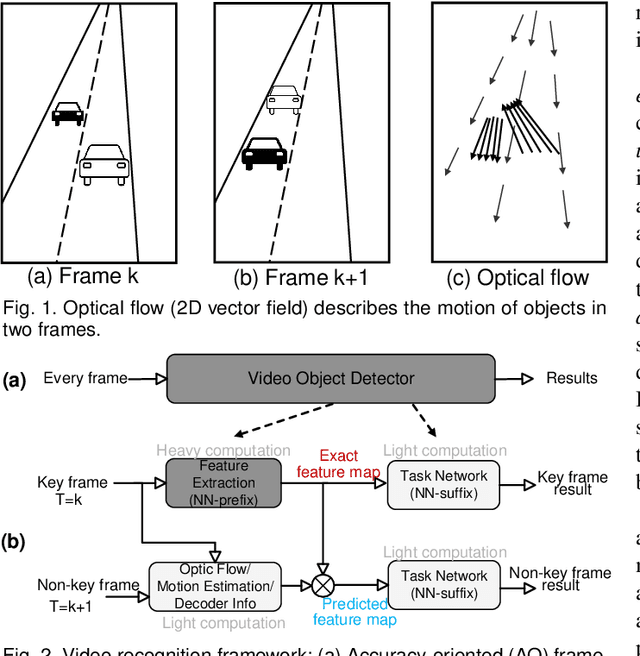

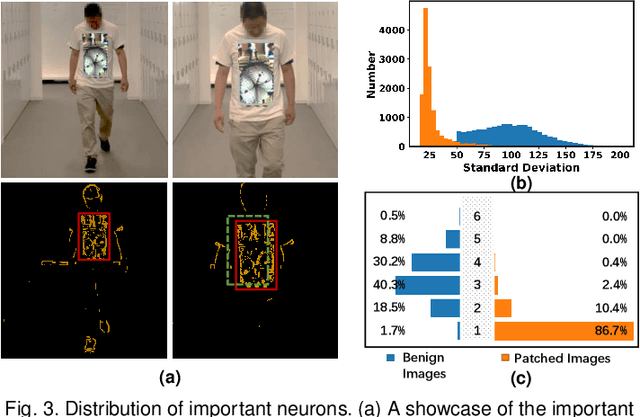
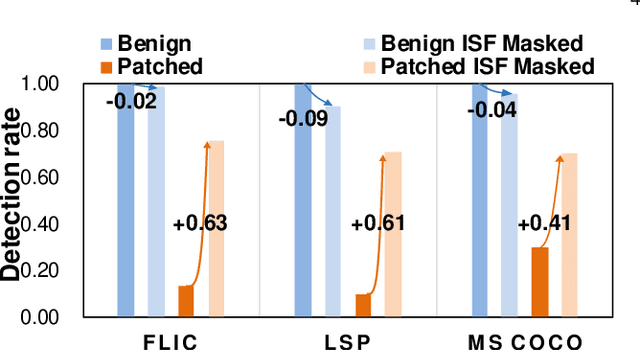
Abstract:DNN-based video object detection (VOD) powers autonomous driving and video surveillance industries with rising importance and promising opportunities. However, adversarial patch attack yields huge concern in live vision tasks because of its practicality, feasibility, and powerful attack effectiveness. This work proposes Themis, a software/hardware system to defend against adversarial patches for real-time robust video object detection. We observe that adversarial patches exhibit extremely localized superficial feature importance in a small region with non-robust predictions, and thus propose the adversarial region detection algorithm for adversarial effect elimination. Themis also proposes a systematic design to efficiently support the algorithm by eliminating redundant computations and memory traffics. Experimental results show that the proposed methodology can effectively recover the system from the adversarial attack with negligible hardware overhead.
 Add to Chrome
Add to Chrome Add to Firefox
Add to Firefox Add to Edge
Add to Edge